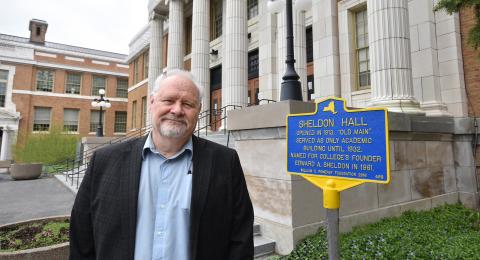Markers at Sheldon Hall, Shady Shore honor college, community history
Office of Communications and Marketing
Published
SUNY Oswego has installed historical markers at two century-plus-old landmarks on campus, Sheldon Hall and Shady Shore -- the culmination of a project that began in the summer of 2017.
The college's Facilities Services installed the informative blue and gold signs, thanks to the work of campus researchers and the Historic Roadside Marker Program, funded through grants of the William G. Pomeroy Foundation.
Michael Flanagan, director of Tyler Art Gallery, worked with Angelo Andreula, then a history major and museum studies minor, who did an internship with the gallery in summer 2017.
“Most students, visitors to campus and even faculty are unaware of the historic nature of those two campus buildings, even if they pass by them frequently,” Flanagan said.
Originally known as Old Main, Sheldon Hall was the college's only building on the present campus from its 1913 opening until Park Hall debuted in 1932. Shady Shore was built as a family home in 1857 by Edward Austin Sheldon, founder of the Oswego Primary Teachers' Training School -- forebear to SUNY Oswego -- and has served as the residence of the college's presidents for decades.
“Professor Flanagan and I worked together to write what is on the markers. There is a specific criteria and format that the markers needed to adhere to,” Andreula said. "Text is limited by marker size.” The markers have a title line, five lines of text in all-capital letters and a Pomeroy Foundation credit.
Historical inquiries
Sheldon Hall, already on the National Register of Historic Places, was formally dedicated 104 years ago, the year World War I began in Europe. Renovated inside and out over the years, the building has endured two major fires and a temporary closing to remain the college's flagship, with its distinctive neo-classical architecture featuring large white columns and a cupola. Today it accommodates classes and serves as home to Admissions, Development, International Education and Programs, and as a residence for students and visitors. Its ballroom hosts many performances and other events.
Shady Shore has served as college President Deborah F. Stanley's family home for more than 20 years. The Stanleys often host receptions and dinners in Shady Shore's tasteful lakeside surroundings.
Andreula enjoyed the search for information on the two historic structures. “The markers gave me an opportunity to implement the skills I have gained throughout my academic career while at Oswego. Researching and drafting a grant proposal was a great experience for me,” he said.
“I went through books in the library, we contacted and worked with the Oswego Historical Society, Penfield Library staff and Oswego Public Library staff. I then drafted the grant proposal and worked with the school financial office to help fill out financial forms,” Andreula said.
The project received substantial assistance in fact verification from Kathryn Johns-Masten in Special Collections at Penfield Library and Justin White, Oswego County historian, Flanagan said. Mitch Fields, associate vice president for facilities services, also assisted and worked in conjunction with Andreula and Flanagan.
The roadside markers at SUNY Oswego are accessible to the public. Sheldon Hall’s marker is located at the foot of the main entrance's steps. Shady Shore’s sign is along Rudolph Street in front of the residence.
Since 2006, the Syracuse-based William G. Pomeroy Foundation has made grants for historic markers, according to the Historic Roadside Marker Program's website. The program commemorates historic people, places or things within the time frame of 1740 through 100 years ago by awarding funds to municipalities and not-for-profit organizations for a marker, mounting pole and shipping. Grantees are responsible for the installation of the marker.



